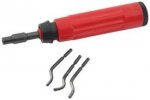malachi constant
Senior Member
- Location
- Minneapolis
Hi all,
I am designing a lighting retrofit where the Owner requests a one-for-one replacement of highbay lights. The lights are currently hard-wired, and the Owner wants the new lights to be connected via cord and plug. There are a few hundred fixtures and downtime (plus other costs) needs to be limited. The hardest part to factor is the conduits disappear up into a fabric insulation ceiling which presents two problems. One, the insulation may or may not be hiding junction boxes. And two, it is difficult (impossible) to visually trace conduits to see what goes to where. I'm concerned that we will need to cut the conduits a few feet short to allow the outlet box to be installed, but in cutting the conduit short we will sever the wire within it. It will be hard to pull back wire given the conditions.
I tentatively proposed a solution that sounds viable but I've never heard it done before: use something like a pipe-cutter (like used on copper plumbing pipes) to cut two feet off the EMT without damaging the wires within. Drop off the two feet and slide a box over the end. Is this something that is done? The maintenance folks thought it was a slam dunk idea but before I sent it out for public bid I figure I better make sure it is a viable option.
I'm guessing I'll hear other solutions from the community, so will add a little more information. Most of the fixtures already have a cord and plug, we're talking about maybe 15% of the fixtures. We'd like to keep them all in the same location at the same height - it's a nice existing grid that lines up with a number of other systems, limiting the ability to move things over or drop the heights. It's a high-profile event space, with some arena seating that will keep some spectators near eye level with the lighting, bolstering the need to keep it looking clean and neat. All that to say it would be really nice to cut the conduit a couple feet short without severing the wire.
Let me know your thoughts. Thanks!
I am designing a lighting retrofit where the Owner requests a one-for-one replacement of highbay lights. The lights are currently hard-wired, and the Owner wants the new lights to be connected via cord and plug. There are a few hundred fixtures and downtime (plus other costs) needs to be limited. The hardest part to factor is the conduits disappear up into a fabric insulation ceiling which presents two problems. One, the insulation may or may not be hiding junction boxes. And two, it is difficult (impossible) to visually trace conduits to see what goes to where. I'm concerned that we will need to cut the conduits a few feet short to allow the outlet box to be installed, but in cutting the conduit short we will sever the wire within it. It will be hard to pull back wire given the conditions.
I tentatively proposed a solution that sounds viable but I've never heard it done before: use something like a pipe-cutter (like used on copper plumbing pipes) to cut two feet off the EMT without damaging the wires within. Drop off the two feet and slide a box over the end. Is this something that is done? The maintenance folks thought it was a slam dunk idea but before I sent it out for public bid I figure I better make sure it is a viable option.
I'm guessing I'll hear other solutions from the community, so will add a little more information. Most of the fixtures already have a cord and plug, we're talking about maybe 15% of the fixtures. We'd like to keep them all in the same location at the same height - it's a nice existing grid that lines up with a number of other systems, limiting the ability to move things over or drop the heights. It's a high-profile event space, with some arena seating that will keep some spectators near eye level with the lighting, bolstering the need to keep it looking clean and neat. All that to say it would be really nice to cut the conduit a couple feet short without severing the wire.
Let me know your thoughts. Thanks!


